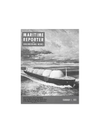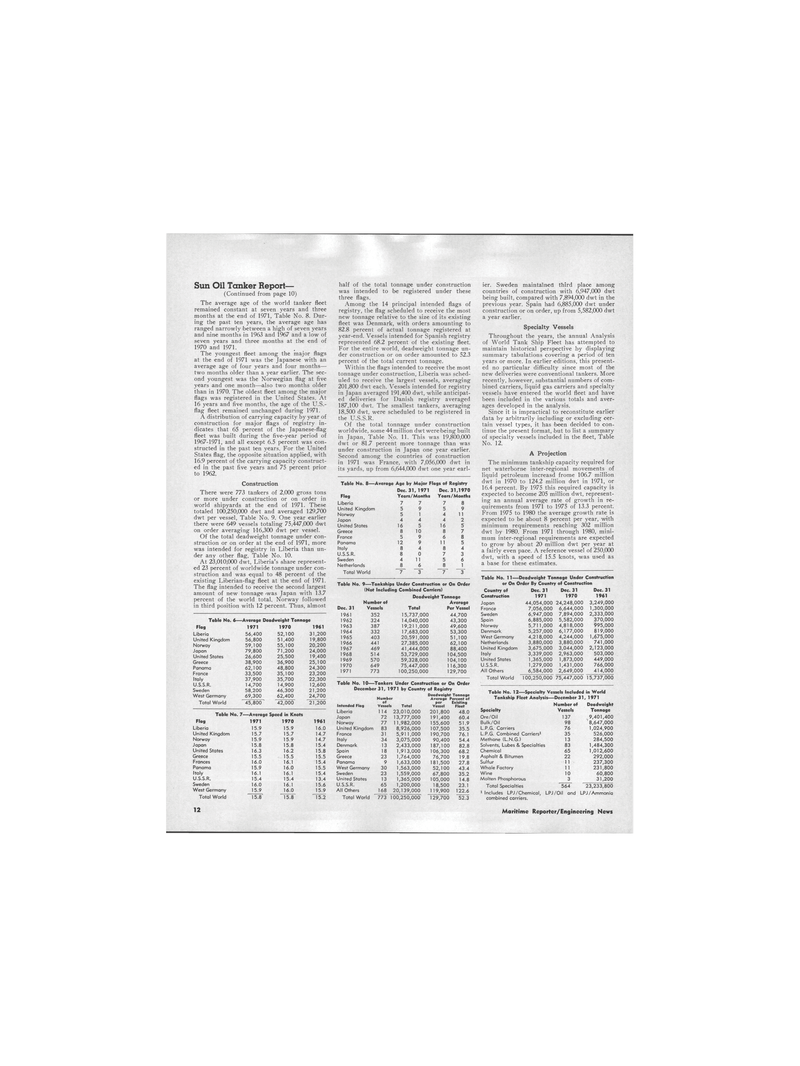
Page 10: of Maritime Reporter Magazine (February 1973)
Read this page in Pdf, Flash or Html5 edition of February 1973 Maritime Reporter Magazine
Sun Oil Tanker Report— (Continued from page 10)
The average age of the world tanker fleet remained constant at seven years and three months at the end of 1971, Table No. 8. Dur- ing the past ten years, the average age has ranged narrowly between a high of seven years and nine months in 1963 and 1967 and a low of seven years and three months at the end of 1970 and 1971.
The youngest fleet among the major flags at the end of 1971 was the Japanese with an average age of four years and four months— two months older than a year earlier. The sec- ond youngest was the Norwegian flag at five years and one month—also two months older than in 1970. The oldest fleet among the major flags was registered in the United States. At 16 years and five months, the age of the U.S.- flag fleet remained unchanged during 1971.
A distribution of carrying capacity by year of construction for major flags of registry in- dicates that 65 percent of the Japanese-flag fleet was built during the five-year period of 1967-1971, and all except 6.5 percent was con- structed in the past ten years. For the United
States flag, the opposite situation applied, with 16.9 percent of the carrying capacity construct- ed in the past five years and 75 percent prior to 1962.
Construction
There were 773 tankers of 2,000 gross tons or more under construction or on order in world shipyards at the end of 1971. These totaled 100,250,000 dwt and averaged 129,700 dwt per vessel, Table No. 9. One year earlier there were 649 vessels totaling 75,447,000 dwt on order averaging 116,300 dwt per vessel.
Of the total deadweight tonnage under con- struction or on order at the end of 1971, more was intended for registry in Liberia than un- der any other flag, Table No. 10.
At 23,010,000 dwt, Liberia's share represent- ed 23 percent of worldwide tonnage under con- struction and was equal to 48 percent of the existing Liberian-flag fleet at the end of 1971.
The flag intended to receive the second largest amount of new tonnage was Japan with 13.7 percent of the world total. Norway followed in third position with 12 percent. Thus, almost
Table No. 6—Average Deadweight Tonnage
Flag 1971 1970 1961
Liberia 56,400 52,100 31,200
United Kingdom 56,800 51,400 19,800
Norway 59,100 55,100 20,200
Japan 79,800 71,200 24,000
United States 26,600 25,500 19,400
Greece 38,900 36,900 25,100
Panama 62,100 48,800 24,300
France 33,500 35,100 23,200
Italy 37,900 35,700 22,300
U.S.S.R. 14,700 14,900 12,600
Sweden 58,200 46,300 21,200
West Germany 69,300 62,400 24,700
Total World 45,800 42,000 21,200
Table No. 7 —Average Speed in Knots
Flag 1971 1970 1961
Liberia 15.9 15.9 16.0
United Kingdom 15.7 15.7 14.7
Norway 15.9 15.9 14.7
Japan 15.8 15.8 15.4
United States 16.3 16.2 15.8
Greece 15.5 15.5 15.5
Frances 16.0 16.1 15.4
Panama 15.9 16.0 15.5
Italy 16.1 16.1 15.4
U.S.S.R. 15.4 15.4 13.4
Sweden 16.0 16.1 15.6
West Germany 15.9 16.0 15.9
Total World 15.8 15.8 15.2 half of the total tonnage under construction was intended to be registered under these three flags.
Among the 14 principal intended flags of registry, the flag scheduled to receive the most new tonnage relative to the size of its existing fleet was Denmark, with orders amounting to 82.8 percent of actual tonnage registered at year-end. Vessels intended for Spanish registry represented 68.2 percent of the existing fleet.
For the entire world, deadweight tonnage un- der construction or on order amounted to 52.3 percent of the total current tonnage.
Within the flags intended to receive the most tonnage under construction, Liberia was sched- uled to receive the largest vessels, averaging 201,800 dwt each. Vessels intended for registry in Japan averaged 191,400 dwt, while anticipat- ed deliveries for Danish registry averaged 187,100 dwt. The smallest tankers, averaging 18,500 dwt, were scheduled to be registered in the U.S.S.R.
Of the total tonnage under construction worldwide, some 44 million dwt were being built in Japan, Table No. 11. This was 19,800,000 dwt or 81.7 percent more tonnage than was under construction in Japan one year earlier.
Second among the countries of construction in 1971 was France, with 7,056,000 dwt in its yards, up from 6,644,000 dwt one year earl-
Table No. 8—Average Age by Major Flags of Registry
Dec. 31,1971 Dec. 31,1970
Flag Years/Months Years/Months
Liberia 7 7 7 8
United Kingdom 5 9 5 9
Norway 5 1 4 11
Japan 4 4 4 2
United States 16 5 16 5
Greece 8 10 8 7
France 5 9 6 8
Panama 12 9 11 5
Italy 8 4 8 4
U.S.S.R. 8 0 7 3
Sweden 4 11 5 6
Netherlands 8 6 8 1
Total World 7 3 7 3
Table No. 9—Tankships Under Construction or On Order (Not Including Combined Carriers)
Deadweight Tonnage
Number of Average
Dec. 31 Vessels Total Per Vessel 1961 352 15,737,000 44,700 1962 324 1 4,040,000 43,300 1963 387 19,21 1,000 49,600 1964 332 17,683,000 53,300 1965 403 20,591,000 51,100 1966 441 27,385,000 62,100 1967 469 41,444,000 88,400 1968 514 53,729,000 104,500 1969 570 59,328,000 104,100 1970 649 75,447,000 1 16,300 1971 773 100,250,000 129,700
Table No. 10—Tankers Under Construction or On Order
December 31, 1971 by Country of Registry
Intended Flag
Number of
Vessels Total
Deadweight Tonnage
Average Percent of per Existing
Vessel Fleet
Liberia 1 14 23,010,000 201,800 48.0
Japan 72 13,777,000 191,400 60.4
Norway 77 1 1,982,000 155,600 51.9
United Kingdom 83 8,926,000 107,500 35.5
France 31 5,91 1,000 190,700 76.1
Italy 34 3,075,000 90,400 54.4
Denmark 13 2,433,000 187,100 82.8
Spain 18 1,913,000 106,300 68.2
Greece 23 1,764,000 76,700 19.8
Panama 9 1,633,000 181,500 27.8
West Germany 30 1,563,000 52,100 43.4
Sweden 23 1,559,000 67,800 35.2
United States 13 1,365,000 105,000 14.8
U.S.S.R. 65 1,200,000 18,500 23.1
All Others 168 20,139,000 119,900 122.6
Total World 773 100,250,000 129,700 52.3 ier. Sweden maintained third place among countries of construction with 6,947,000 dwt being built, compared with 7,894,000 dwt in the previous year. Spain had 6,885,000 dwt under construction or on order, up from 5,582,000 dwt a year earlier.
Specialty Vessels
Throughout the years, the annual Analysis of World Tank Ship Fleet has attempted to maintain historical perspective by displaying summary tabulations covering a period of ten years or more. In earlier editions, this present- ed no particular difficulty since most of the new deliveries were conventional tankers. More recently, however, substantial numbers of com- bined carriers, liquid gas carriers and specialty vessels have entered the world fleet and have been included in the various totals and aver- ages developed in the analysis.
Since it is impractical to reconstitute earlier data by arbitrarily including or excluding cer- tain vessel types, it has 'been decided to con- tinue the present format, but to list a summary of specialty vessels included in the fleet, Table
No. 12.
A Projection
The minimum tankship capacity required for net waterborne inter-regional movements of liquid petroleum increasd frome 106.7 million dwt in 1970 to 124.2 million dwt in 1971, or 16.4 percent. By 1975 this required capacity is expected to become 205 million dwt, represent- ing an annual average rate of growth in re- quirements from 1971 to 1975 of 13.3 percent.
From 1975 to 1980 the average growth rate is expected to be about 8 percent per year, with minimum requirements reaching 302 million dwt by 1980. From 1971 through 1980, mini- mum inter-regional requirements are expected to grow by about 20 million dwt per year at a fairly even pace. A reference vessel of 250,000 dwt, with a speed of 15.5 knots, was used as a base for these estimates.
Table No. 11—Deadweight Tonnage Under Construction or On Order By Country of Construction
Country of Dec. 31 Dec. 31 Dec. 31
Construction 1971 1970 1961
Japan 44,054,000 24,248,000 3,249,000
France 7,056,000 6,644,000 1,300,000
Sweden 6,947,000 7,894,000 2,333,000
Spain 6,885,000 5,582,000 370,000
Norway 5,71 1,000 4,818,000 995,000
Denmark 5,257,000 6,177,000 819,000
West Germany 4,218,000 4,244,000 1,675,000
Netherlands 3,880,000 3,880,000 741,000
United Kingdom 3,675,000 3,044,000 2,123,000
Italy 3,339,000 2,963,000 503,000
United States 1,365,000 1,873,000 449,000
U.S.S.R. 1,279,000 1,431,000 766,000
All Others 6,584,000 2,649,000 414,000
Total World 100,250,000 75,447,000 15,737,000
Table No. 12—Specialty Vessels Included in World
Tankship Fleet Analysis—December 31, 1971
Number of Deadweight
Specialty Vessels Tonnage
Ore/Oil 137 9,401,400
Bulk/Oil 98 18,647,000
L.P.G. Carriers 76 1,024,900
L.P.G. Combined Carriers1 35 526,000
Methane (L.N.G.) 13 284,500
Solvents, Lubes & Specialties 83 1,484,300
Chemical 65 1,012,600
Asphalt & Bitumen 22 292,000
Sulfur 1 1 237,300
Whale Factory 1 1 231,800
Wine 10 60,800
Molten Phosphorous 3 31,200
Total Specialties 564 23,233,800 1 Includes LPJ/Chemical, LPJ/Oil and LPJ/Ammonia combined carriers. 12 Maritime Reporter/Engineering News

 9
9

 11
11
